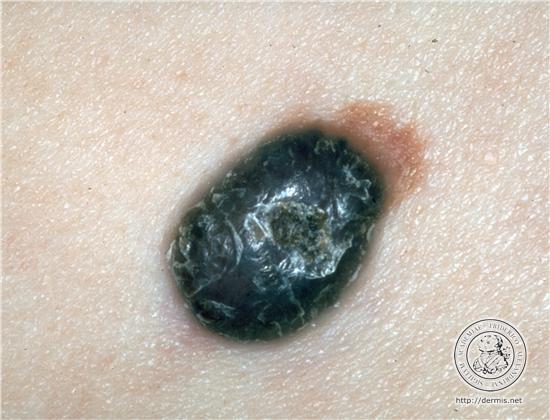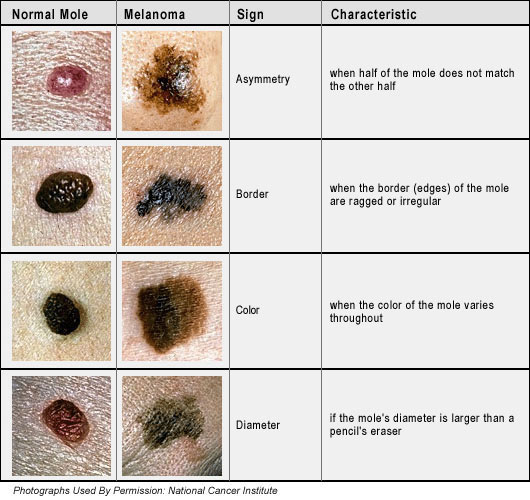What is a Malignant Melanoma?
 Cutaneous malignant melanoma is a cancer of the pigment cells of the skin. If it is treated early, the outlook is usually good. It is not contagious.
Cutaneous malignant melanoma is a cancer of the pigment cells of the skin. If it is treated early, the outlook is usually good. It is not contagious.
The word ‘melanoma’ comes from the Greek word ‘melas’, meaning black. Melanin is the dark pigment that gives the skin its natural colour. Melanin is made in the skin by pigment cells called melanocytes. After our skin is exposed to sunlight, the melanocytes make more melanin, and so the skin becomes darker.
Melanocytes sometimes grow together in harmless groups or clusters, which are known as moles. Most people have between 10 and 50 moles and often they are darker than the surrounding skin.
Melanomas can come up in or near to a mole, but can also appear on skin that looks quite normal. They develop when the skin pigment cells (melanocytes) become cancerous and multiply in an uncontrolled way. They can then invade the skin around them and may also spread to other areas such as the lymph nodes, liver and lungs.
What causes melanoma?
The most important preventable cause is exposure to too much ultraviolet light in sunlight, especially during the first 20 years of life. There is lots of evidence linking melanoma to this, and melanomas are especially common in white-skinned people who live in sunny countries. The use of artificial sources of ultraviolet light, such as sun beds, also raises the risk of getting a melanoma.
Some people are more likely to get a melanoma than others:
- People who burn easily in the sun are particularly at risk. Melanoma occurs most often in fair-skinned people who tan poorly. Often they have blond or red hair, blue or green eyes, and freckle easily. Melanomas are less common in dark-skinned people.
- Past episodes of severe sunburn, often with blisters, and particularly in childhood, increase the risk of developing a melanoma. However, not all melanomas are due to sun exposure, and some appear in areas that are normally kept covered.
- People with many (more than 50) ordinary moles, or with a very large dark hairy birthmark, have a higher than average chance of getting a melanoma.
- Some people have many unusual (atypical) moles (known as ‘dysplastic naevi’). They tend to be larger than ordinary moles, to be present in large numbers, and to have irregular edges or colour patterns. The tendency to have these ‘dysplastic naevi’ can run in families and carries an increased risk of getting a melanoma.
- The risk is raised if another family member has had a melanoma.
- People who have already had one melanoma are at an increased risk of getting another one.
- People with a damaged immune system (e.g. as a result of an HIV infection or taking immunosuppressive drugs, perhaps after an organ transplant) have an increased chance of getting a melanoma.
Are melanomas hereditary?
About 1 in 10 of people with a melanoma have family members who have also had one. There are several reasons for this. Fair skin is inherited; dysplastic naevi can run in families, as can a tendency to have large numbers of ordinary moles.
What are the symptoms of melanoma?
Melanomas may not cause any symptoms at all, but tingling or itching may occur at an early stage. Some melanomas start as minor changes in the size, shape or colour of an existing mole (see below): others begin as a dark area that can look like a new mole. Later on a melanoma may feel hard and lumpy, and bleed, ooze or crust up.
What does a melanoma look like?
All melanomas do not look the same, and there are several different types. The ABCD system (below) tells you some of the things to look out for. A melanoma may show one or more of the following features:
- Asymmetry — the two halves of the area differ in their shape.
- Border — the edges of the area may be irregular or blurred, and sometimes show notches.
- Colour — this may be uneven. Different shades of black, brown and pink may be seen.
- Diameter - most melanomas are at least 6 mm. in diameter.

Melanomas can appear on any part of the skin but they are most common in men on the body, and in women on the legs.
How is a melanoma diagnosed?
If you are at all worried about changes in a mole, or about a new area of pigmentation appearing on your skin, you should see your family doctor. The ABCD changes listed above can sometimes be found in completely harmless conditions, and your doctor will often be able to put your mind at rest quickly. However, if there is still any doubt, your doctor will usually refer you to a specialist (a dermatologist or a surgeon with a special interest in pigmented lesions) who will examine the area, perhaps with a special instrument (a dermatoscope), and decide whether it needs to be removed. The only way in which the diagnosis of a melanoma can be made firmly is by looking at the suspected area under microscope in the laboratory.
If the mole needs to be examined further, the whole of the suspicious area will then be removed under a local anaesthetic (an excision biopsy) and sent to the laboratory to be examined. If the area is too large to remove easily, a sample of it (a biopsy) will be taken. If a melanoma is found, the biopsy specimen will provide valuable information about its type and depth that will help to plan the next step in treatment.
Can a melanoma be cured?
Yes: three quarters of the people who have a melanoma removed will have no further problems. However it is crucial for a melanoma to be removed as early as possible - before it has had time to spread deep into the skin or to other parts of the body. The thinner the melanoma is when it is removed; the better is the survival rate. This is why a doctor should examine anyone with a suspicious mole or blemish as soon as possible. In a small minority of people the melanoma may have spread but further surgery or chemotherapy can often help to control this.
How can a melanoma be treated?
At present, the treatment for melanoma is surgical. There is no other treatment of proven benefit, and usually no other tests are needed. Radiotherapy is of little benefit, and various drugs have been tried, but with limited success only.
Most people who have had a melanoma removed will need another operation to try to prevent the melanoma from coming back at the original site. During the operation, some healthy skin will be removed from around the original scar to make absolutely sure that all of the melanoma has been taken away, and this makes the scar larger than before. Occasionally a skin graft will be needed.
“Sentinel node biopsy” may be discussed with some people. In this, a small sample of the nearest lymph node is taken as an additional procedure when the melanoma is being removed. However sentinel node biopsy is not used routinely, and is usually performed only as part of a research study: it is not an essential part of treatment.
After your operation you will be followed up regularly in the outpatient clinic. There are three main reasons for this:
- To make sure the tumour has not come back or spread.
- To detect any other skin cancers.
- To provide you with support and information.
At the clinic your scar will be checked, and your neck, groin and armpits will also be examined for lumps to detect any spread to the lymph nodes there. Any other moles that you are concerned about will be examined and, if you have large numbers of moles, an eye will be kept on these too. Photographs of these moles may be taken and kept in your hospital notes. When you come back to the clinic, they will allow your doctors to compare the way your moles look now with how they looked before.
If your melanoma was at a very early stage when it was removed, you may need to be seen only once more in the follow-up clinic. Otherwise you will be reviewed 3-monthly for at least 3 years. If you develop problems between clinic appointments, you should consult your family doctor who will arrange for an earlier hospital appointment if this is necessary.
What can I do?
Once your melanoma has been treated, you should be able to get back to a normal lifestyle quite quickly. You should also take a few sensible precautions to stop yourself getting another one:
- You should look at all areas of your skin monthly for moles that are growing, or changing in the ways listed in the ABCD rules (see above). There is no way that you can memorise all your existing moles, but you will notice subconsciously if any mole begins to change or if a new mole develops. It is as if someone has moved something in one of your rooms at home — it looks wrong. If you find any worrying changes, contact your doctor immediately.
- You must also protect yourself from too much sun. This does not mean that you can’t ever go on a sunny holiday again; it just means that you need to be careful to avoid sunbathing and burning. You can do this by covering yourself up and using sun protection creams.
- Covering up is better than using a sunscreen. Wear long sleeves, use a hat when out in the sun, and wear long trousers rather than shorts. Use clothing with a tight weave that will block ultraviolet light. Avoid the sun particularly from 11 a.m. until 3 p.m. - when its rays are strongest. Seek shade whenever possible. Use a high factor sunscreen (factor 30 or above) on areas you can’t cover. A broad spectrum one is best, as it will block both types of ultraviolet radiation (UVA and UVB). Put it on half an hour before going out and reapply it at least every 2 hours, but don’t use these sunscreens as an excuse to stay out in the sun or not to bother with protective clothing. Avoid sun beds and tanning lamps. Share sun advice and other information with blood relatives as they also may be at increased risk of getting a melanoma. In particular, protect your children from the sun, as exposure during childhood seems to be particularly damaging.
Top sun safety tips
- Protect the skin with clothing, including a hat, T shirt and UV protective sunglasses
- Seek shade between 11am and 3pm when it’s sunny
- Use a sunscreen of at least SPF 30 which also has high UVA protection
- Keep babies and young children out of direct sunlight
Sunscreens should not be used as an alternative to clothing and shade, rather they offer additional protection. No sunscreen will provide 100% protection.

